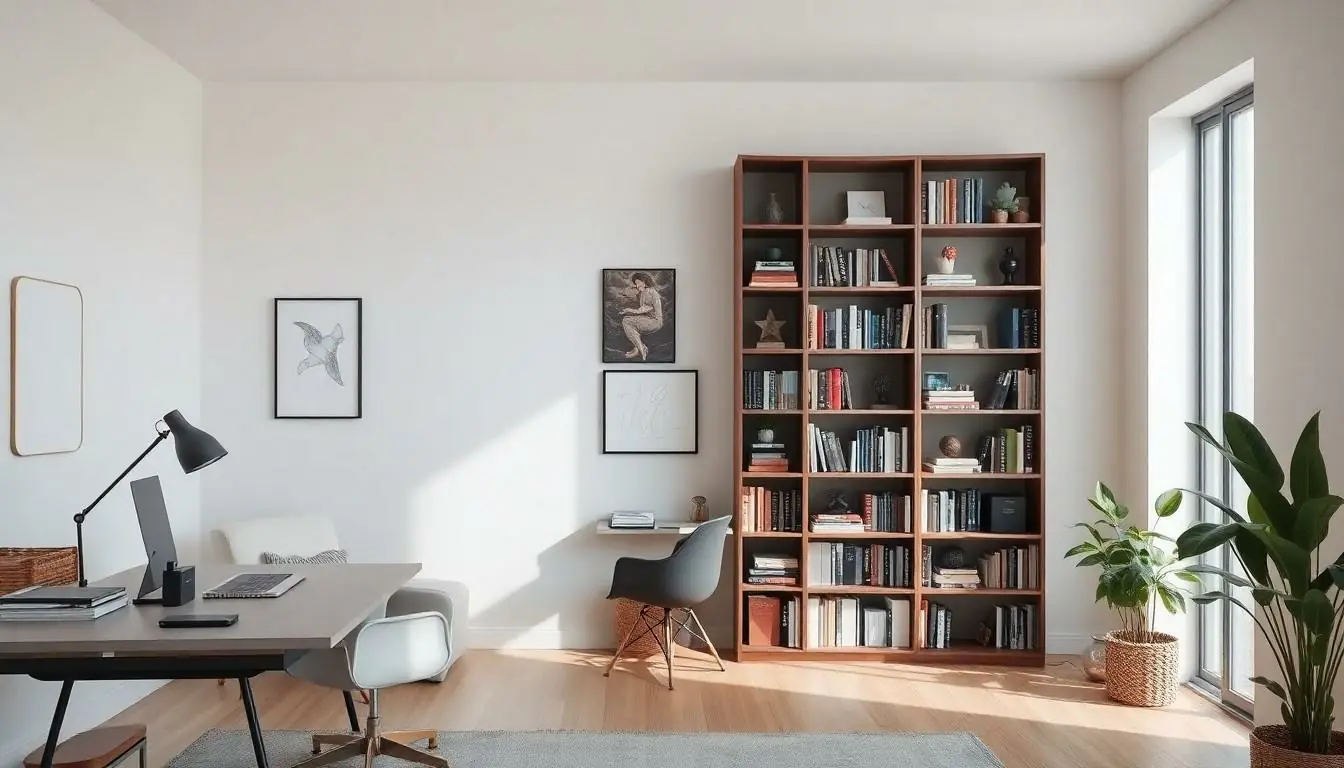In the age of remote work, home offices have transformed from makeshift desks to stylish sanctuaries. But let’s face it—what’s a home office without a bookshelf that screams, “I’m a professional, but I also know how to binge-watch my favorite series”? A well-designed bookshelf isn’t just for holding books; it’s a statement piece that can inspire creativity and organization.
Imagine stepping into a space where every novel, binder, and quirky knick-knack is perfectly displayed, making you feel like the CEO of your own life. A home office bookshelf can elevate your workspace from drab to fab, and let’s be honest, it’ll give your Zoom background that much-needed upgrade. So, whether you’re a bookworm or a casual reader, let’s dive into the world of home office bookshelves and discover how to turn that cluttered corner into a chic haven of productivity.
Table of Contents
ToggleOverview of Home Office Bookshelves
Home office bookshelves combine function and design, adding value to workspace organization. They provide storage for books, office supplies, and decorative items, lending practicality and style. By incorporating a bookshelf, individuals can create a visually appealing and clutter-free setting that enhances productivity.
Various styles of bookshelves exist, catering to diverse tastes. Some prefer modern, sleek designs, while others opt for classic wooden finishes, ensuring that every workspace reflects personal style. Adjustable shelves allow flexibility, accommodating items of different sizes.
In addition to their aesthetic appeal, bookshelves serve specific purposes. They can display awards, photographs, and plants, contributing to a personalized atmosphere. Open shelving showcases a curated collection, inviting creativity and inspiration. Closed cabinets offer a tidy appearance by hiding less visually appealing materials.
Material choices influence durability and design. Solid wood, metal, and laminate constructions each provide distinct looks and functionalities. Selecting high-quality materials improves longevity, ensuring bookshelves withstand daily use.
Strategic placement of bookshelves is crucial in optimizing space. Situating them near desks promotes easy access to reading materials. Their positioning can also impact the overall flow of the office, contributing to a more balanced environment.
Investing in bookshelves represents a strategic choice for enhancing home office settings. They not only serve practical storage needs but also play a significant role in establishing a cohesive look. By prioritizing design and functionality, individuals can elevate their workspaces significantly.
Types of Home Office Bookshelves

Home office bookshelves come in various styles, each catering to different preferences and spatial needs. Choosing the right type enhances both functionality and aesthetics in a workspace.
Freestanding Bookshelves
Freestanding bookshelves offer versatility in placement. These units stand on the floor and can be easily moved to adjust the room’s layout. Constructed in different styles and sizes, they cater to both compact and expansive spaces. Individuals often choose tall models for maximum storage without occupying much floor space. Adjustable shelves allow customization, accommodating books as well as decorative items. Some freestanding options include built-in cabinets, providing hidden storage for office supplies.
Wall-Mounted Bookshelves
Wall-mounted bookshelves save valuable floor space while adding a modern touch. Installed directly on walls, these shelves create an illusion of openness in smaller rooms. Many designs come in modular formats, allowing for personal arrangement according to taste. Wall-mounted options can showcase books and artwork simultaneously, promoting a curated look. Ideal for home offices, these shelves make organization simple while enhancing visual appeal. Various materials, including wood and metal, ensure durability and style coherence with existing décor.
Corner Bookshelves
Corner bookshelves utilize underappreciated space efficiently. They fit snugly into room corners, transforming an often-neglected area into functional storage. Angular designs allow for unique displays of various items, enhancing creativity in organization. Some styles incorporate additional storage like drawers or cabinets, maximizing utility. Corner bookshelves vary in height and shape, offering options for different office sizes. An inviting design turns any corner into a focal point while maintaining a clutter-free environment.
Key Features to Consider
Selecting the right bookshelf for a home office involves evaluating several key features that enhance both functionality and style.
Material and Durability
Choosing robust materials ensures longevity. Solid wood provides durability and a classic appeal, while metal offers a modern touch and can withstand wear. Particleboard may be budget-friendly but often lacks the durability of higher-quality options. Consider finishes as well; laminated surfaces resist scratches and stains, making them practical for daily use. Opting for environmentally friendly materials, such as sustainably sourced wood or recycled metal, not only supports sustainability but also adds character to the workspace.
Size and Space Optimization
Assessing available space determines the size and style of the bookshelf. Measuring the intended area helps maximize efficiency and ensures it doesn’t overwhelm the room. Tall bookshelves utilize vertical space effectively, making them ideal for smaller offices. Bantam models can fit snugly in corners, especially in tight spots. Modular systems allow for customization, providing flexibility to adapt to changing needs. Prioritizing a bookshelf that suits both spatial constraints and organizational requirements creates a more functional workplace.
Design and Aesthetics
Selecting a design that complements the overall office decor enhances visual appeal. Minimalist styles evoke a clean and modern aesthetic, while traditional designs add warmth and a classic touch. Color choices significantly influence the atmosphere; lighter shades promote openness, whereas darker hues can add sophistication. Incorporating decorative elements like open shelving creates an inviting display for books and personal items. Prioritizing cohesive design aspects allows the bookshelf to serve as both a practical storage solution and a statement piece that elevates the office ambience.
Tips for Organizing Home Office Bookshelves
Organizing a home office bookshelf enhances both functionality and style. Various approaches can streamline this process and create a visually appealing workspace.
Arranging by Subject or Genre
Grouping books by subject or genre promotes easy access. Fiction novels can reside together, while business books occupy another section. This method aids in finding specific titles quickly, leading to an overall efficient workspace. Consider utilizing labels for each category, adding clarity to the organization. Such labels not only provide seamless navigation but also serve to showcase personal interests and expertise. Ultimately, an organized bookshelf creates a calm environment that fosters productivity.
Incorporating Decorative Elements
Incorporating decorative elements adds personality to a bookshelf while enhancing its visual appeal. Mixing books with plants introduces greenery, improving air quality and aesthetics. Artisan objects or framed photos can serve as personal touches, breaking the monotony of rows of books. Strategically placing decorative items between books maintains a sense of balance. Using cohesive colors or themes throughout the decorations helps unify the look. Such thoughtful arrangements elevate the overall atmosphere of the home office, making it more inviting and inspiring.
Investing in a stylish and functional bookshelf can significantly elevate a home office. It’s not just about storing books; it’s about creating an inspiring environment that boosts creativity and organization. By selecting the right type and design of bookshelf, individuals can reflect their personal style while optimizing their workspace.
Thoughtful organization and strategic placement of bookshelves can enhance both aesthetics and functionality. Incorporating decorative elements adds personality and fosters a calm atmosphere conducive to productivity. Ultimately, a well-designed bookshelf serves as a focal point that transforms an ordinary office into an inviting and efficient workspace.



